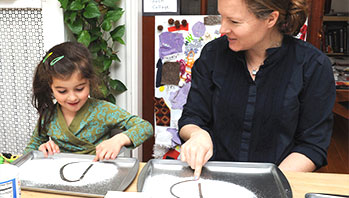- chart paper
- highlighter marker
- letter card “Pp”
- marker
MA Standards:
Foundational Skills/RF.PK.MA.2: With guidance and support, demonstrate understanding of spoken words, syllables, and aounds (phonemes).
Head Start Outcomes:
Literacy Knowledge/Alphabet Knowledge: Recognizes that the letters of the alphabet are a special category of visual graphics that can be individually named.
Language Development/Receptive Language: Attends to language during conversations, songs, stories, or other learning experiences.
Literacy Knowledge/Phonological Awareness: An awareness that language can be broken into words, syllables, and smaller pieces of sound.
PreK Learning Guidelines:
English Language Arts/Reading and Literature 7: Develop familiarity with the forms of alphabet letters, awareness of print, and letter forms.
Learn About Letters Together: “Peter Piper Paints” #2

© Commonwealth of Massachusetts, Department of Early Education and Care (Jennifer Waddell photographer). All rights reserved.
ELA Focus Skills: Follow Directions, Letter Recognition, Speaking and Listening, Vocabulary
Educator Prep: Copy the words to the poem “Peter Piper Paints” onto chart paper.
Draw children’s attention to the “Peter Piper Paints” poem chart.
- Point to the words as you read aloud the title.
- Read the title again and ask, What letter do you see at the beginning of each word in the title?
- As children respond, highlight each "Pp." Repeat the process for each line of the poem.
Once you have read and highlighted each word that begins with "Pp," tell children you are going to read the poem again and this time you will clap out the syllables in each word that begins with "Pp."
- Read the poem slowly and clap out the "Pp" words. Have children repeat after you.
- Continue for each line as children repeat after you.
Allow time for children to illustrate the chart or tape on pictures of the objects mentioned in the chart.
Take It Further: Tell children clap out only one-syllable words that begin with "Pp." Then only two-syllable words, then only three-syllable words.
Educator Tip: Invite children to say the poem quickly. Explain that "Peter Piper Paints" is call a "tongue twister" and it is difficult to say quickly because all the "p" words make your tongue get all twisted up!
Educator Tip: Guided and independent letter, sound, and word practice continues to take place in center activities. It is helpful to set up the literacy center immediately after the direct instruction and repeat instruction before children work in the literacy center identifying letters.
Adaptation: If you have children of varying ages in your group, have older children make "Peter Piper Paints" books, making a page for each "Pp" word (Peter, paints, picture, penguin, pie, polka-dot, potato, pink, purple).
English Language Learners: If children are not familiar with the objects mentioned in the poem, have pictures on hand so you can hold a picture up as you mention the object. Once children gain familiarity, ask them to find the picture and hold it up as the group recites the line of the poem.
Peter Piper Paints
Peter Piper paints a picture of a penguin.
Peter Piper paints a picture of a pie.
Peter Piper paints a polka-dot potato.
Peter Piper paints a pink and purple sky.
